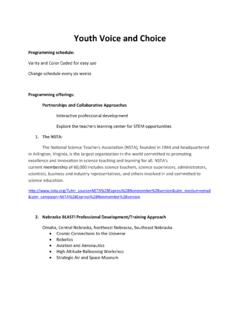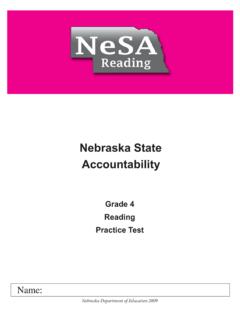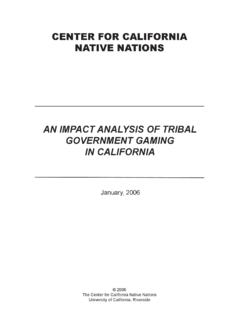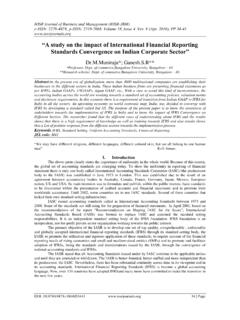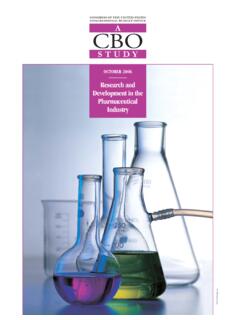Transcription of 3/1/11 Preliminary Depth of Knowledge Analysis Comp. Cur ...
1 3/1/11 1 Preliminary Depth of Knowledge Analysis Grade Band K-2 Indicators and DOK Comp. Cur. Ind. Curricular Indicators (Cur. Ind.) DOK INQUIRY AND NATURE OF SCIENCE Abilities to do Scientific Inquiry Ask questions that relate to a science topic 2 Conduct simple investigations 2 Select and use simple tools appropriately 1 Describe objects, organisms, or events using pictures, words, and numbers 2 Collect and record observations 2 Use drawings and words to describe and share observations with others 2 Use appropriate mathematics in all aspects of scientific inquiry 2 PHYSICAL SCIENCE Matter Observe physical properties of objects (freezing and melting, sinking and floating, color, size, texture, shape, weight)
2 2 Separate and sort objects by physical attributes 2 Measure objects using standard and non-standard units 1 Identify solids and liquids and recognize that liquids take the shape of their container 2 Force and Motion State location and/or motion relative to another object or its surroundings (in front of, behind, between, over, under, faster, slower, forward and backward, up and down) 2 Describe how objects move in many different ways (straight, zigzag, round and round, back and forth, fast and slow) LIFE SCIENCE Structure and Function of Living Systems Differentiate between living and nonliving things 2 Identify the basic needs of living things (food, water, air, space, and shelter) 1 Identify external parts of plants and animals 1 Observe and match plants and animals to their distinct habitats 2 Heredity Describe how offspring resemble their parents 1 Describe how living things change as they grow 1 BioDiversity Recognize seasonal changes in animals and plants 1 EARTH AND SPACE SCIENCE Earth in Space Identify objects in the sky (the Sun, the Moon, stars)
3 And when they are observable 2 Identify objects that appear to move in the sky (the Sun, the Moon, stars) 1 Earth Structures and Processes Describe Earth materials (sand, soil, rocks, water) 1 Recognize ways in which individuals and families can conserve Earth s resources by reducing, reusing, and recycling 1 Energy in Earth s Systems Observe that the Sun provides heat and light 1 Observe and describe simple daily changes in weather 2 Describe simple seasonal weather indicators and how they impact student choices (activities, clothing) 2 3/1/11 2 Preliminary Depth of Knowledge Analysis Grade Band 3-5 Indicators and DOK Comp. Cur.
4 Ind. Curricular Indicators (Cur. Ind.) DOK INQUIRY AND NATURE OF SCIENCE Abilities to do Scientific Inquiry Ask testable scientific questions 2 Plan and conduct investigations and identify factors that have the potential to impact an investigation 3 Select and use equipment correctly and accurately 1 Make relevant observations and measurements 2 Collect and organize data 2 Develop a reasonable explanation based on collected data 3 Share information, procedures, and results with peers and/or adults 2 Provide feedback on scientific investigations 3 Use appropriate mathematics in all aspects of scientific inquiry 2 Nature of Science Recognize that scientific explanations are based on evidence and scientific Knowledge 1 Recognize that new discoveries are always being made which impact scientific Knowledge 1 Recognize many different people study science 1 Technology Identify a simple problem 2 Propose a solution to a simple problem 2 Implement the proposed solution 3 Evaluate the implementation 3 Communicate the problem, design.
5 And solution 2 PHYSICAL SCIENCE Matter Identify mixtures and pure substances 1 Identify physical properties of matter (color, odor, elasticity, weight, volume) 1 Use appropriate metric measurements to describe physical properties 1 Identify state changes caused by heating and cooling solids, liquids, and gases 1 Force and Motion Describe motion by tracing and measuring an object s position over a period of time (speed) 2 Describe changes in motion due to outside forces (push, pull, gravity) 1 Describe magnetic behavior in terms of attraction and repulsion 1 Energy Recognize that sound is produced from vibrating objects.
6 The sound can be changed by changing the vibration 1 Recognize that light travels in a straight line and can be reflected by an object (mirror) 1 Recognize that light can travel through certain materials and not others (transparent, translucent, opaque) 1 Identify ways to generate heat (friction, burning, incandescent light bulb) 1 Identify materials that act as thermal conductors or insulators 1 Recognize that the transfer of electricity in an electrical circuit requires a closed loop 1 3/1/11 3 Preliminary Depth of Knowledge Analysis Grade Band 3-5 Indicators and DOK Comp. Cur. Ind. Curricular Indicators (Cur. Ind.) DOK LIFE SCIENCE Structure and Function of Living Systems Compare and contrast characteristics of living and nonliving things 2 Identify how parts of plants and animals function to meet basic needs ( leg of an insect helps an insect move, root of a plant helps the plant obtain water)
7 1 Heredity Identify inherited characteristics of plants and animals 1 Identify the life cycle of an organism 1 Flow of Matter and Energy in Ecosystems Diagram and explain a simple food chain beginning with the Sun 2 Identify the role of producers, consumers, and decomposers in an ecosystem 1 Recognize the living and nonliving factors that impact the survival of organisms in an ecosystem 1 Recognize all organisms cause changes, some beneficial and some detrimental, in the environment where they live 1 Biodiversity Describe adaptations made by plants or animals to survive environmental changes 1 EARTH AND SPACE SCIENCE Earth in Space Recognize that the observed shape of the Moon changes from day to day during a one month period 1 Recognize the motion of objects in the sky (the Sun, the Moon, stars)
8 Change over time in recognizable patterns 1 Earth Structures and Processes Describe the characteristics of rocks, minerals, soil, water, and the atmosphere 1 Identify weathering, erosion, and deposition as processes that build up or break down Earth s surface 1 Identify how Earth materials are used (fuels, building materials, sustaining plant life) 1 Energy in Earth s Systems Describe the Sun s warming effect on the land and water 1 Observe, measure, and record changes in weather (temperature, wind direction and speed, precipitation) 2 Recognize the difference between weather, climate, and seasons 1 Earth s History Describe how slow processes (erosion, weathering, deposition) and rapid processes (landslides, volcanic eruptions, earthquakes) change Earth s surface 1 3/1/11 4 Preliminary Depth of Knowledge Analysis Grade Band 6-8 Indicators and DOK Comp.
9 Cur. Ind. Curricular Indicators (Cur. Ind.) DOK INQUIRY AND NATURE OF SCIENCE Abilities to do Scientific Inquiry Formulate testable questions that lead to predictions and scientific investigations 2 Design and conduct logical and sequential investigations including repeated trials 3 Determine controls and use dependent (responding) and independent (manipulated) variables 3 Select and use equipment appropriate to the investigation, demonstrate correct techniques 1 Make qualitative and quantitative observations 2 Record and represent data appropriately and review for quality, accuracy, and relevancy 3 Evaluate predictions, draw logical inferences based on observed patterns/relationships, and account for non-relevant information 3 Share information, procedures, results.
10 And conclusions with appropriate audiences 2 Analyze and provide appropriate critique of scientific investigations 3 Use appropriate mathematics in all aspects of scientific inquiry 2 Nature of Science Recognize science is an ongoing process and the scientific community accepts and uses explanations until they encounter new experimental evidence not matching existing explanations 1 Describe how scientific discoveries influence and change society 2 Recognize scientists from various cultures have made many contributions to explain the natural world 1 Technology Identify problems for technological design 2 Design a solution or product 3 Implement the proposed design 3 Evaluate completed technological designs or products 3 Communicate the process of technological design 2 Distinguish between scientific inquiry (asking questions about the natural world) and technological design (using science to solve practical problems) 1 Describe how science and technology are reciprocal 1 Recognize that solutions have intended and unintended consequences 1 Compare and contrast the reporting of scientific Knowledge and the reporting of technological Knowledge 2 3/1/11 5 Preliminary Depth of Knowledge Analysis Grade Band 6-8 Indicators and DOK Comp.

